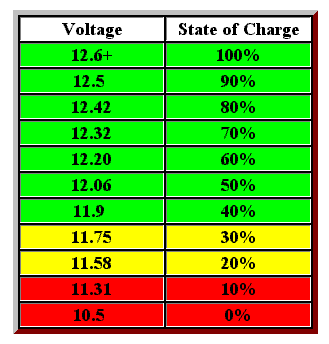TomG2 wrote:
"Everybody" says to not drain 12 volt batteries below 12.0 volts. Operating a small refrigerator drops the apparent voltage to 11.9 volts which recovers to 12.5 volts between cycles. Too low or can I wait until the idle voltage drops to 12.0 volts?
12v resting is about 40% SOC. You can do that a lot. No big deal.
While loaded as with an inverter running a 120v fridge, you might see 11 volts if the battery is getting low. Inverter will alarm and let you know it! when inverter sees 10.5 volts it will quit and battery voltage will go back up.
Idea is to have enough battery on the inverter (and fat enough wires) so you don't get the inverter alarm before your next battery recharge.

